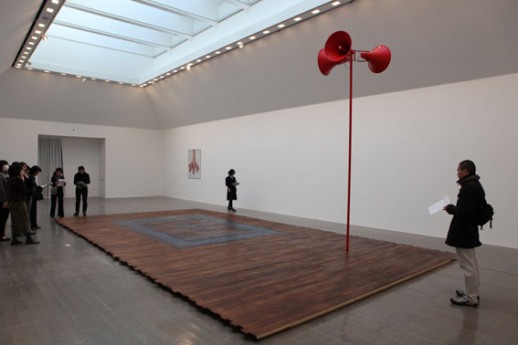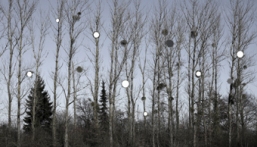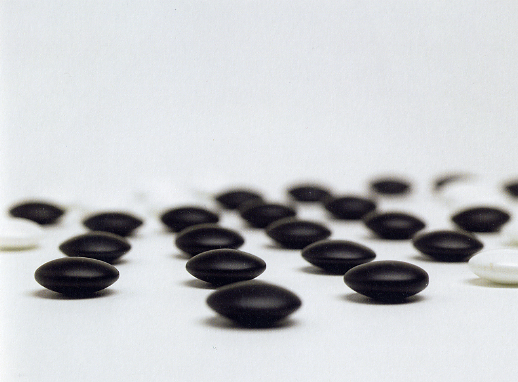Landscapes Between Sites and Sounds
Tse Su-Mei’s self-titled solo exhibition introduces a lyrical body of artworks, which delve into the aural as much as the visual world. This, her first solo exhibition in Japan, presents a number of video projections, large and small installations, and photography. Born to an English pianist mother and Chinese violinist father, Tse’s artworks roam between sites and sounds, from European beaux arts traditions (classical music, marble fountains, etc.) through East Asian cultural motifs (bonsai, neon Chinese characters, etc.), and back. Often with subtle wit and humour, Tse’s most effective work manages to broaden the sensory possibilities of the exhibition space itself, particularly with the attention she gives to sound.
Born and raised in Luxembourg, Tse at first studied both visual arts and music, specializing in the cello. Though she eventually chose to pursue a career as a ‘visual’ artist rather than a musician, her musical background often informs her artistic projects. For example, the publicity image used for the Mito exhibition is taken from a video titled ‘L’écho’ (2003), which shows Tse at her cello with her back to us, perched on a grassy cliff, facing a large alpine precipice. As she intermittently bows her cello, an echo ostensibly comes from the rocky wall of surrounding mountains. However, just as this is not a ‘natural’ image but a composed one, this chorus of echoing mountains at times anticipates the cello player, or returns a variation of the cello’s sound, toying with the ‘dialogue’ between the artist and nature. Previous works referenced her classical music training more literally, such as in ‘La Marionette’ (1999), an early video work (not shown in the current exhibition), in which the artist is shown seated, facing the viewer/camera, playing the cello, while her limbs are attached to numerous strings, which manipulate her like a marionette.

A more recent video projection, ‘Mistlepartition’ (Mistle Score, 2006), shows a row of tall slender trees, with odd clumps of mistletoe foliage at various heights amongst the otherwise leafless branches. The trees scroll past, and a piece of classical music for strings begins. As particular notes are struck, corresponding white circles appear on the screen, fading in and out over the clumps of mistletoe; notes of a higher pitch become white circles higher up the tree, lower notes accordingly are represented lower down.
Tse won a Golden Lion at the Venice Biennale in 2003, at only thirty years of age, and has swiftly established an international presence, showing in Europe, America, China, Taiwan, and now Japan. Tse’s works, a handful of which are collaborations with Jean-Lou Majerus (a Luxembourg based artist), appear to have become more conceptually ambitious in the past few years, although with mixed results. One of the stronger works, and also the most recent, ‘Many Spoken Words’ (2009), is a whitish stone fountain through which black ink flows. Combined with the title, this work invites myriad associations between writing and monumental history; one can imagine the ‘sounds’ of the splashing ink as the garbled ‘voices’ of countless correspondence. Moreover, the deep, dark black liquid seems oddly like blood as it spits and bubbles over the fountain’s chalky white cherub.
Yet a work such as ‘1000 words for snow’ (2008, in collaboration with Jean-Lou Majerus), while visually and aurally intriguing, is much more esoteric. Bright red speakers loom over one corner of a varnished wooden platform which fills the centre of the exhibition space; into this a Persian carpet design has been carved and painted in indigo blue. The speakers are reported to be looping the crackly sound of snow falling, but this seemed to stop at “mysterious”, rather than readily forming any particular impression. The exhibition’s information leaflet seemed to take the everything-and-nothing approach, suggesting that the notion of “carving/recording” (kizamu) related to human and historical memory, as well as personal experience…and so on, and so forth.

Apart from the works incorporating sound elements, the exhibition includes many sculptural installations, some executed in neon tubing (the exhibition notes suggesting this is a material between light and substance). In addition, there are some photographic works, including a series titled ‘The Master of Go’ (after Yasunari Kawabata) (2006), another collaboration with Majerus. This series is based on the nobel laureate Kawabata’s semi-fictional novel of 1938, of which the Japanese title was Meijin, which traces the months long ‘last match’ of a go champion. For all this rich cultural and literary reference, the photographs are relatively straightforward depictions of a white go board space with its characteristic black and white counters in strategic positions, the contrast of which gives the photographs a highly designed composition, yet appears literally descriptive rather than atmospheric (despite the close-up angles), particularly before an audience for whom the board’s design is not exotic.
Remaining smaller works are objects that reveal something of Tse’s enduring sense of child-like discovery in confronting the world around her. ‘Now’ (2008) is a delightful piece of signage, almost lost on the expansive white walls, on which is simply written “now”. As the light-box sign switches on and off, a poignant word-image is formed; “now on”, “now off”… making one wonder, when does “now” begin or end? Similarly playful, ‘Le Frigo’ (The Fridge, 2000), reverses the usual function of the fridge-light: when the door closes, the light turns on, when open, the light turns off. Tse’s comment, on the wall nearby discusses her childhood pondering, along the lines of “Will the lights in my room stay on, even when I’m not there?…Is my room even there?!” and so on. Tse continues: “Today I still sometimes wonder whether things exist relative to our presence.”
And for those wondering: yes, the fridge light is actually on when the door closes – I checked.
Olivier Krischer
Olivier Krischer



